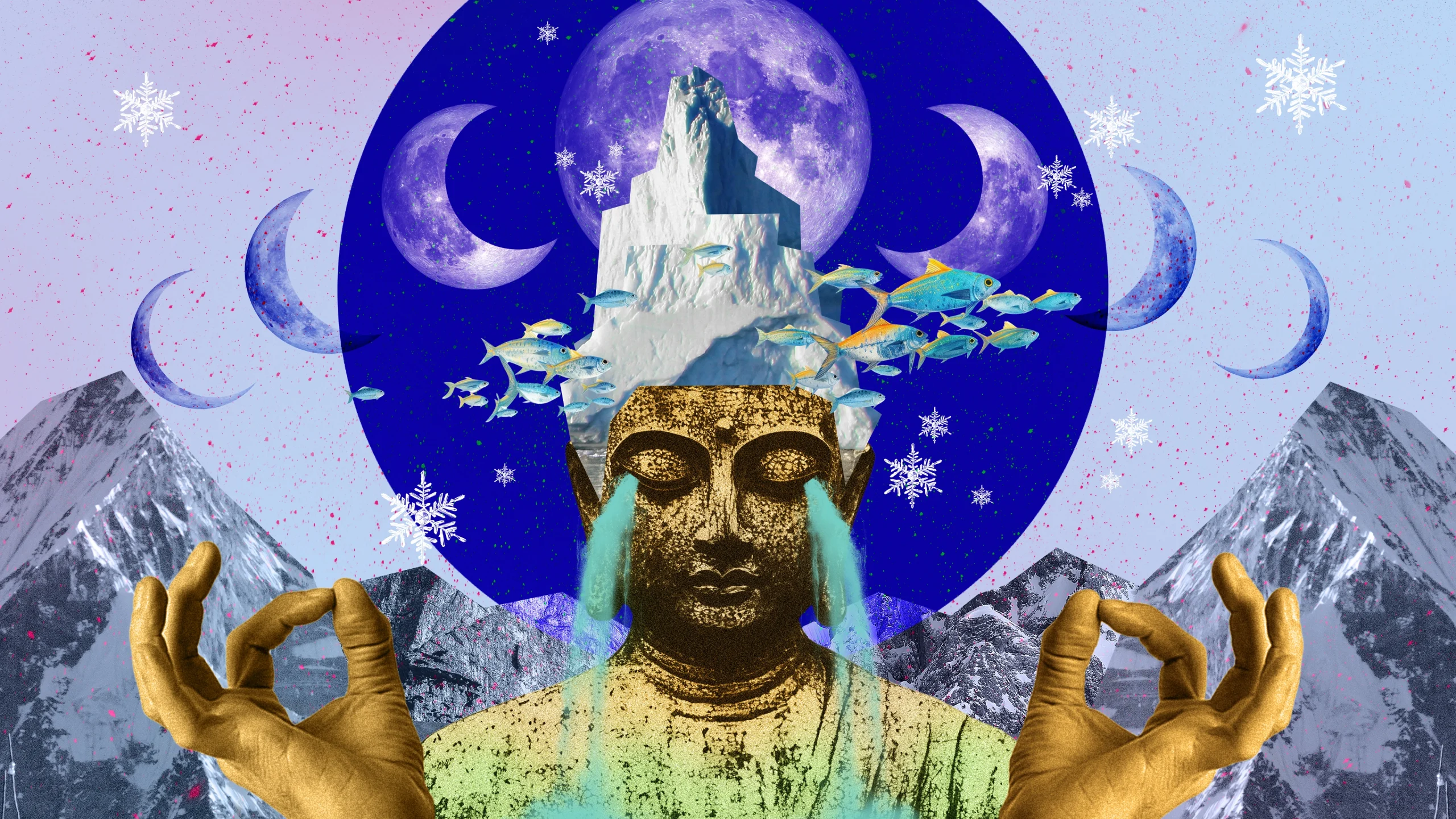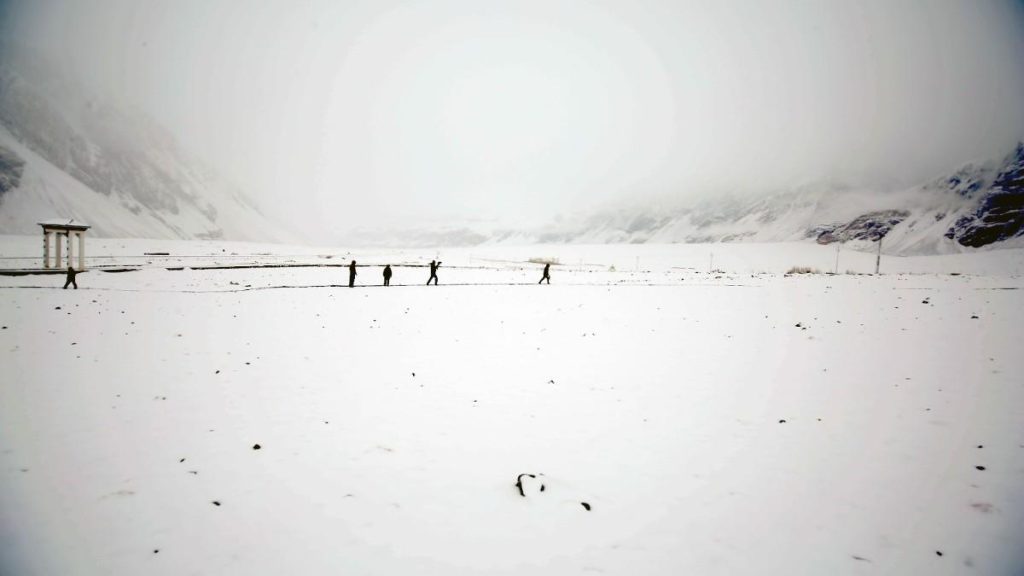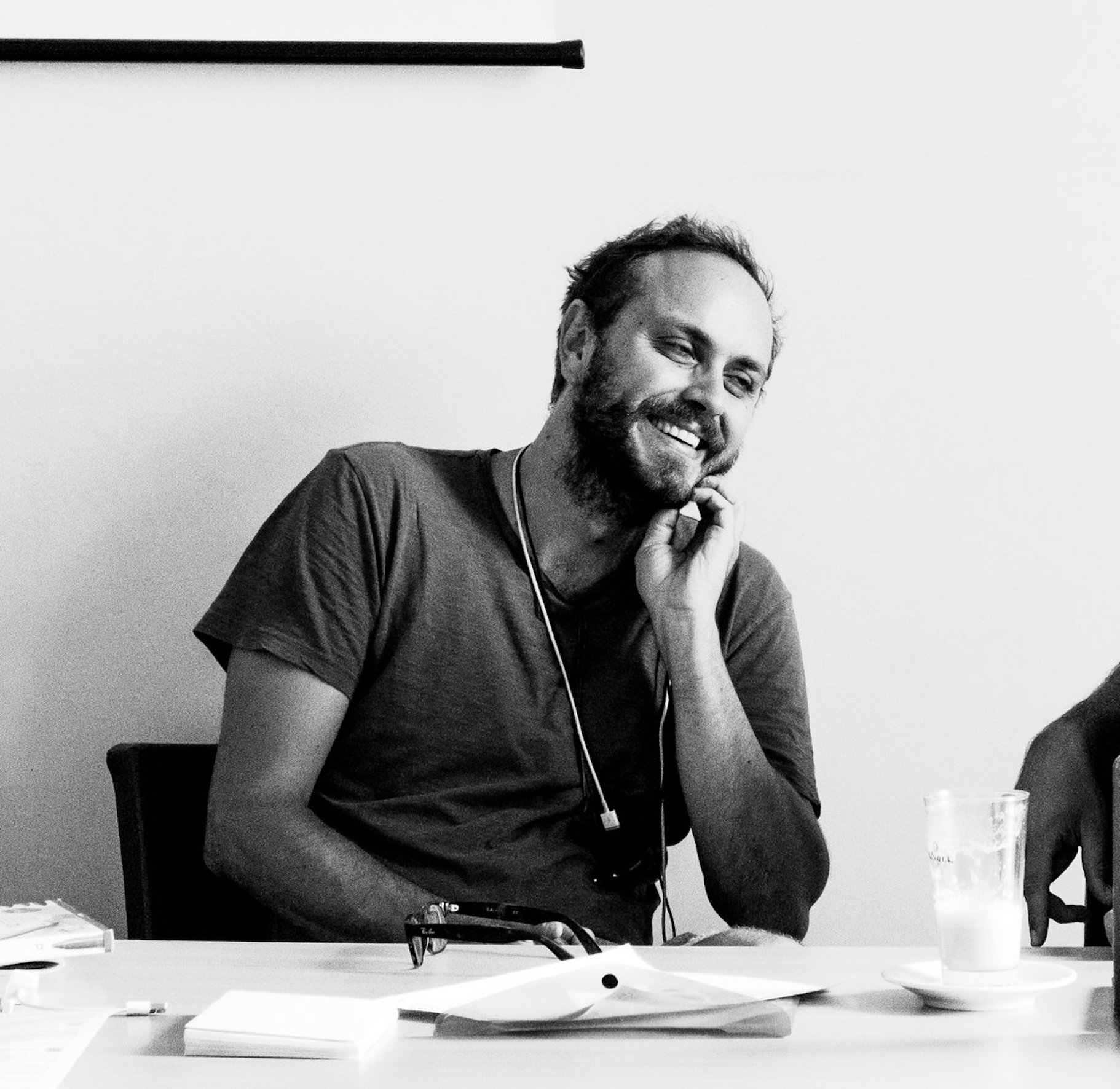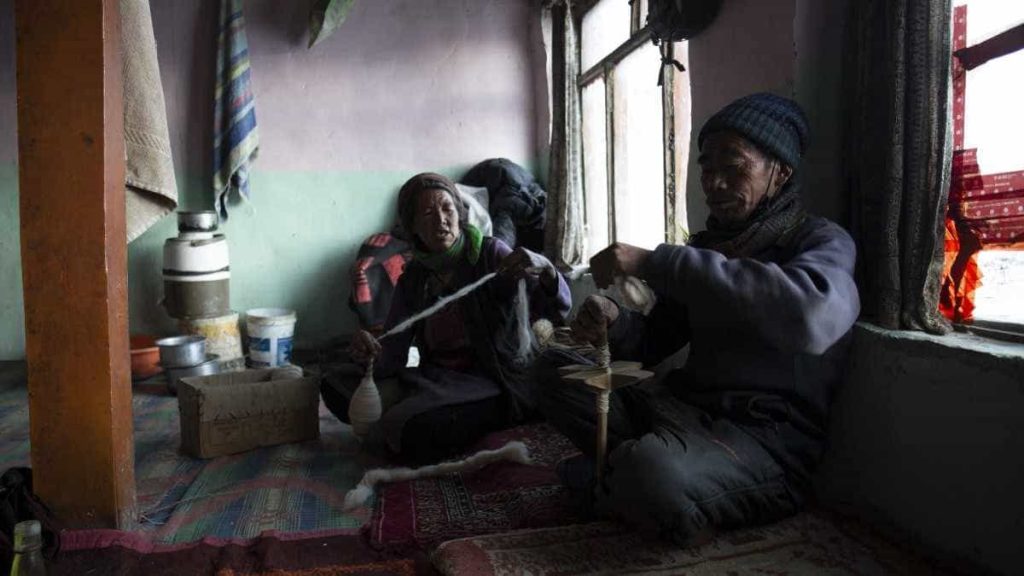
A conversation with Tommaso Barbaro and Francesco Clerici, the directors who portrayed Zanskar (India) through the ice stupas: artificial glaciers created to guarantee water to villages affected by the retreat of natural glaciers. A documentary that tells the story of a community fighting climate change with ingenuity and dignity, leaving the power of narration to the breath of images.
Reaching Zanskar, a valley in northern India, is never easy. Eleven hours by jeep from Leh, the capital of Ladakh, along dirt tracks, mountain passes and snow-covered valleys. At every turn, the landscape becomes more essential: bare rocks, solid silences, thin air burning the lungs. It is here, in this high-altitude desert, that ice stupas, pyramid-shaped ice structures up to forty metres high, are born. They store millions of litres of water for months, releasing them slowly at sowing time. A fragile yet poetic technology that keeps entire villages alive.
For the directors of The Ice Builders (2024), Francesco Clerici and Tommaso Barbaro, this scenario became a set as fascinating as it was challenging. «By day it was between zero and five degrees, by night minus twenty», recalls Barbaro. «That meant camera batteries drained, frozen hands, even cars that would not start. Every day was a challenge, yet it was impossible not to be captivated by the beauty of those ice architectures».

Tommaso Barbaro is a sound editor and sound designer working in cinema, with productions showcased at several international festivals. He has collaborated with directors such as Soldini, Parenti, D’Anolfi, Venier, Marazzi, Testi, Diril and Lucini. In 2019, the documentary “La scomparsa di mia madre” (The Disappearance of My Mother) by Beniamino Barrese, for which he was responsible for sound editing and mixing, was presented in the international competition at the Sundance Film Festival. In 2020, he received a nomination for Best Use of Sound & Music at the Berlin Commercial for “Rumori” by SÄMEN. Alongside his work in cinema, he also works in advertising as a sound designer. From 2016 to 2021, he directed “The Huddle”, his first documentary, distributed on Amazon Prime UK and USA.
Discover moreGo to his Instagram profile
How and where the ice stupas are born
In the heart of the Himalayas, over three thousand metres above sea level, the time of water does not follow human needs. The glaciers that for centuries fed the Zanskar valley in northern India are retreating, melting either too soon or too late compared to the agricultural schedule. To face this crisis, local communities have learnt to build ice pyramids up to forty metres high: the ice stupas. The idea was conceived by engineer and activist Sonam Wangchuk and, since 2013, has been carried forward thanks to collaboration between local communities and organisations such as Trentino for Tibet Odv. The principle is as simple as it is ingenious: during winter, water from streams is channelled through pipes down to the valley floor. Natural pressure pushes it upwards, where it gushes from a nozzle and freezes instantly, forming ice cones. Their pyramidal shape reduces exposure to the sun and slows melting. Thus, when the fields most need water in spring, the artificial glaciers begin to thaw gradually, ensuring irrigation and survival. The idea for the documentary, which recounts their construction step by step and the community’s deep bond with the land, came from Andrea Zatta and the Ice Stupa Zanskar1. project. «When Fabio Saitto, our producer, told us about the ice stupas, we did not even know they existed», recalls Clerici. «But their shape, so similar to Buddhist stupas, made us realise it was not just engineering: there was also a cultural, spiritual and symbolic dimension. That was when we understood there was a film».
A film that took shape following days marked by cold and unpredictability. «We woke up early», says Tommaso Barbaro, «with extremely salty tea, bread, onions, dumplings and stuffed pasta for breakfast. Dishes you would eat for lunch at home, but there you tried them at seven in the morning». Then work began with Lobzang, the guide and protagonist of the film, who led the two directors during the shooting weeks to the strategic points of ice stupa construction: where the pipes were collected, transported and assembled.
«Francesco and I split up to follow the group more closely», continues Barbaro. The day ended early, and by around four, when shadows fell across the valley, the cold became unbearable and we had to return».

Zanskar and its “silent empathy”
If there is one face that remained impressed on the directors’ memory, it is that of Dorjey, one of the builders. «He had this turtle-like face burnt by the sun. He hardly ever spoke, yet he had an immense empathic capacity», says Clerici. A seemingly marginal detail created an unexpected connection: «I left for the shoot wearing my grandfather’s corduroy trousers, the warmest item I owned. One evening, Dorjey, curious, asked Lobzang where they came from. When he learned they had belonged to my grandfather, and that I had grown up with him, an immediate bond was created: he was raising his granddaughter too. From then on, he invited me a couple of times to drink tea with him. We never said a word, but sat there in silence, sharing smiles and gestures».
«It was a form of silent empathy and mutual fondness made of glances more than words».
This same form of communication repeated itself in simple, everyday gestures between the directors and the valley’s inhabitants. «The workers saw us every day for two weeks», recalls Barbaro. «At some point interaction became inevitable. I remember in particular a retirement party for a villager: we knew no one, but a man involved me so that I would sit and eat with them, trying the dishes they had prepared. He asked nothing in return, simply shared for the pleasure of it. That was the way things were: even Lobzang’s mother, who hosted us in her home along with the whole family during filming, was always busy with cooking and chores, yet she still found the time to smile at us and show us how she baked bread. Affectionate communication always emerged, even without words».

Francesco Clerici, who graduated in History and Criticism of Art, is a self-taught documentary filmmaker and university lecturer at the University of Milan, the Politecnico di Milano, IULM Milan, Raffles Milano, ETH Zurich, and visiting professor at the Accademia di Architettura in Mendrisio. His first feature documentary, “Il gesto delle mani” (Hand Gestures), was presented at the 2015 Berlin Film Festival in the FORUM section, where it won the FIPRESCI International Critics’ Award. His works have been screened at festivals worldwide (London Film Festival, Viennale, RIDM Montreal, Dok.fest, Leipzig, Berlinale, the British Film Institute in London, Cineteca Mexicana in Mexico City, the Moscow Documentary Film Centre, the Institute of Contemporary Arts in London, the Barbican, MART in Rovereto). In 2018, the Cinémathèque of Grenoble dedicated a retrospective to his work. His most recent feature-length documentary, “La paz del futuro” (co-directed with Luca Previtali), was presented at the Rome Film Festival in 2022, while the experimental short “Even Tide” won the Special Jury Prize at the Turin Film Festival in 2023. The short film “The Ice Builders”, co-directed with Tommaso Barbaro and filmed in the Himalayas, was presented at the 72nd Trento Film Festival in 2024, before travelling to more than 40 festivals and winning 14 awards.
Discover moreGo to his official web page
Not surprisingly, the only word the directors learnt locally was Jullay: «a word that means many different things depending on the context: beautiful, thank you, good, how are you, everything is fine», explains Clerici. «It is never the word itself that defines its meaning, but the gesture, the look or the situation. Everyone understands what you really mean, without the need for explanation»
The documentary The Ice Builders is nourished precisely by this subtlety: by gestures that mean more than words, and by an exchange that does not need explanation. «Of course, some – like Lobzang himself or others connected to local NGOs – are more used to speaking in front of cameras and discussing climate change. But most of the inhabitants», adds Clerici, «simply carried on with their lives: cooking, building, working. For them, we were “the outside world” coming into their homes, and for that very reason they welcomed us without barriers, as if to say: “come, we will show you our daily life”. It was a generous openness, made more of gestures and presence than of speeches». Of breaths, of the same rarefied air.
When documentary becomes contemplation
The ice stupas are not merely hydraulic engineering: in Zanskar, their conical shape immediately recalls Buddhist stupas, dome-shaped monuments built to hold sacred relics or commemorate events in the Buddha’s life. «The directorial idea», explains Clerici, «was precisely not to portray them as something disconnected from the local cultural fabric, but to embed them in the rhythms, cadences and sensoriality belonging to that context. Not an alien object, as a solar panel might be, but an element arising from the shapes, needs and daily struggles of the valley’s inhabitants».
This focus on intangible heritage is reflected in the style of the film itself: suspended, contemplative, far from the didactic documentary. «I am used to works in which reflections emerge from the images rather than from someone explaining them», Clerici notes.
«Here we sought to balance an informative, necessary part with a more sensory, anthropological one made of sounds, rhythms and gestures. It is far more interesting to create a window through which the viewer can project and let personal reflections emerge».
«That is the power of cinema: to provide clues, open spaces, make resonate in the spectator what is significant for them. Not to explain too much, but to leave many interpretive possibilities open».

For this reason, alongside visual shooting, Tommaso Barbaro recorded with a geophone, an instrument originally designed as a seismic detector capable of capturing frequencies too low for the human ear. «The idea was to give the glacier a voice», says Barbaro, conveying not only what is seen, but also what normally remains hidden: the most intimate and vital dimension of a landscape that lives through silences and breath. «In Zanskar, water flows beneath the snow; often it is not visible, but with the geophone we could truly hear it, in its authentic sound», explains Barbaro. «Thus, in two or three scenes one can hear the ice accompanied by a subterranean, deep noise: the voice of the water itself».
Resilience, resistance or survival?
A red thread running through the screenings of The Ice Builders is the audience’s surprise at such a simple yet ingenious tool. «In general», says Barbaro, «there is always great curiosity. We even presented it at UNESCO2 and each time there are countless questions. Perhaps because ice stupas are not just a technical invention: they are a concrete response to extreme conditions and a daily act of survival».
Not a film “about climate change”, then, but one that makes it tangible. «What happens in Zanskar is the amplified reflection of the consequences of our daily choices in cities.
These are not two separate worlds: we are all on the same planet», adds Barbaro.
Clerici echoes the point: «What struck me most is that the film was appreciated in completely different contexts. From UNESCO glaciologists to primary schools in Nevada, to the local Zanskar population. Everyone grasped the same message: it is not a blaming film, but a proactive one. It is an invitation to act, not to stop at complaints». Living for weeks in such a fragile environment also meant learning from the way local communities face hardship.
«What is striking», says Barbaro, «is the lightness with which they accept adverse conditions. There is almost a grace in facing daily harshness».
«They seek rooted solutions and have a pragmatic attitude: “there is a problem, so we find a way to face it”, they seem to say. The ice stupas were born from exactly this: not from abstract ideology, but from the concrete need to survive in harmony with the landscape».
As Clerici explains, «Bringing water with petrol pumps would have been more “logical” for us Westerners, who tend to complain and curse misfortune. But it would not have been respectful of either nature or communities, which would have been left with fewer resources. Ice stupas are also this: a political act that unites survival, resilience and resistance. A community choosing to adapt without destroying the balance of others».
The survival of Zanskar’s inhabitants translates into resisting without destroying, adapting without breaking the bond with the land and those who will come after. It is a form of resilience that turns little into something vital.
- With the support of Trentino for Tibet Odv, Montura and the Trentino-Alto Adige/Südtirol Region. Find out more: https://www.trentinofortibet.it/progetti-2/ice-stupa-zanskar/. ↩︎
- In Paris, at the opening of the first meeting for 2025, the International Year of Glaciers’ Preservation. ↩︎





